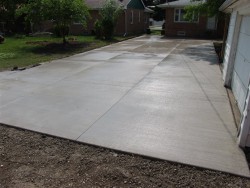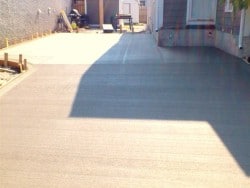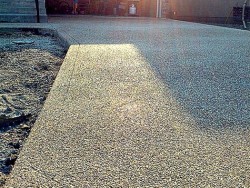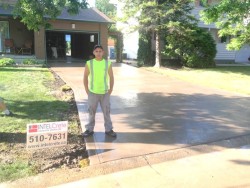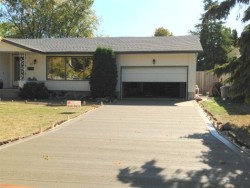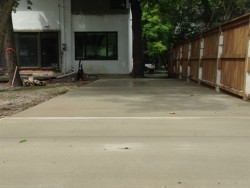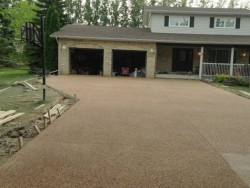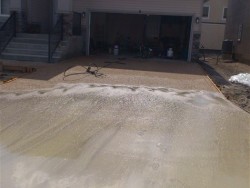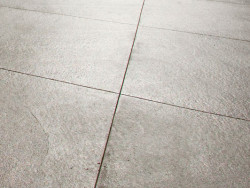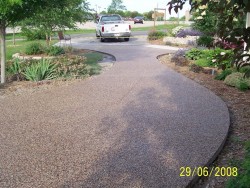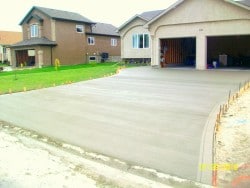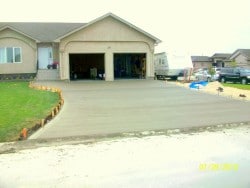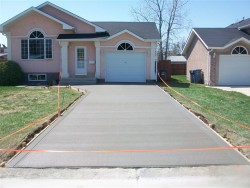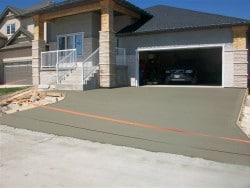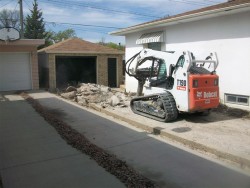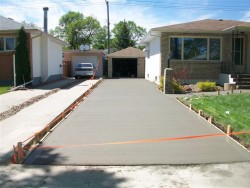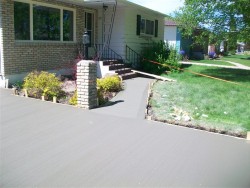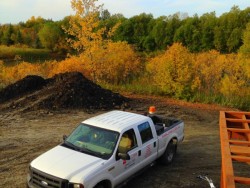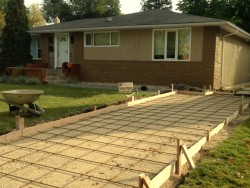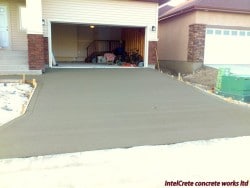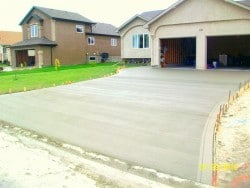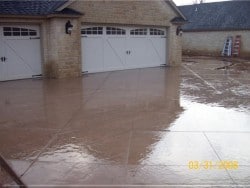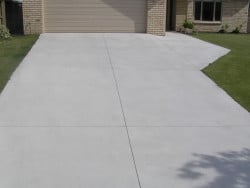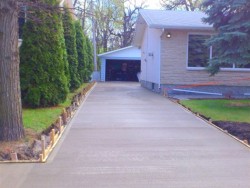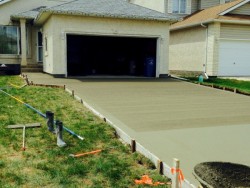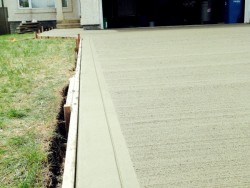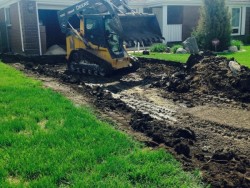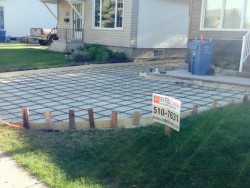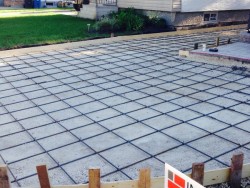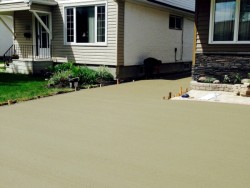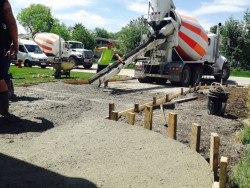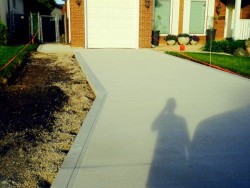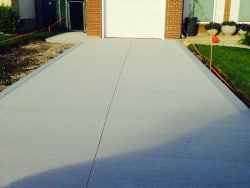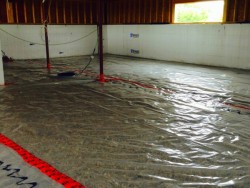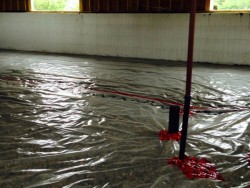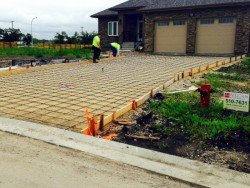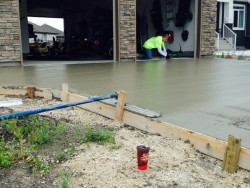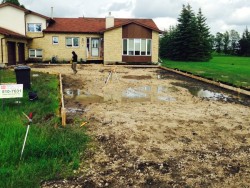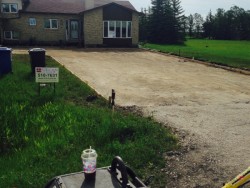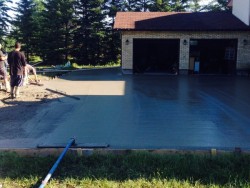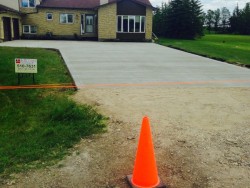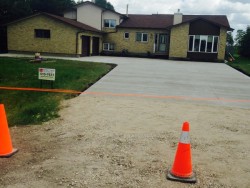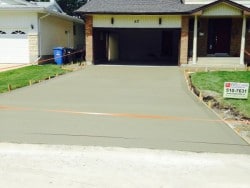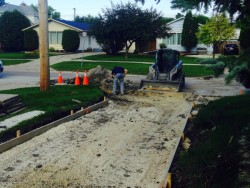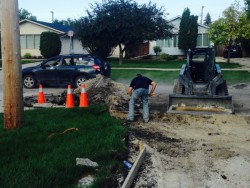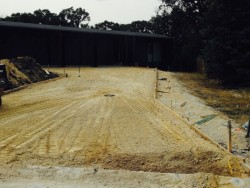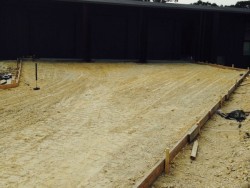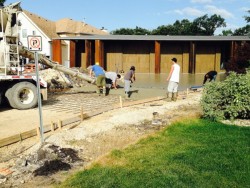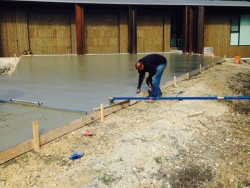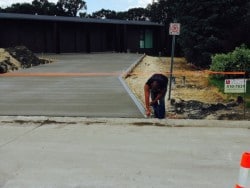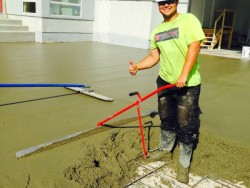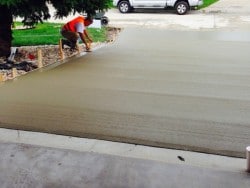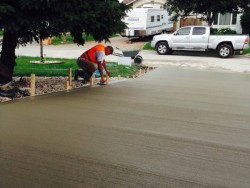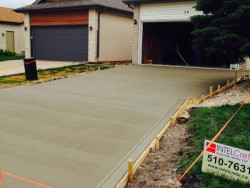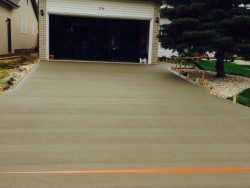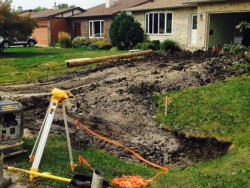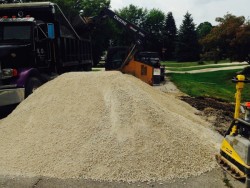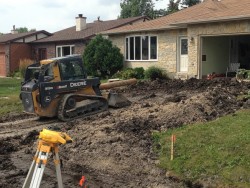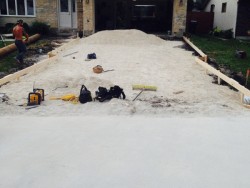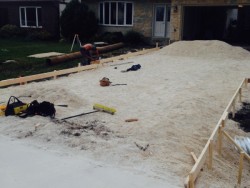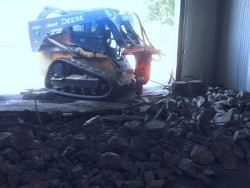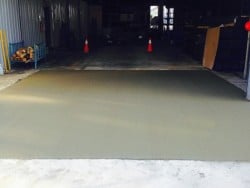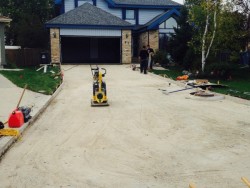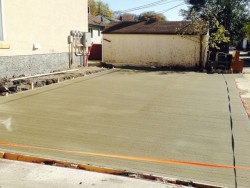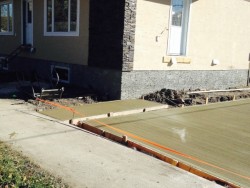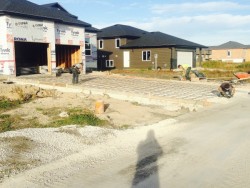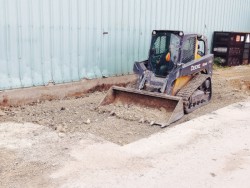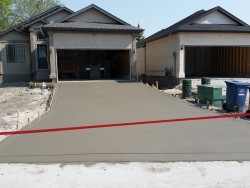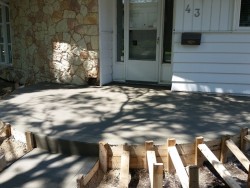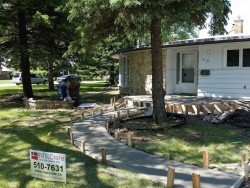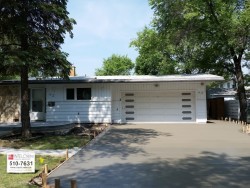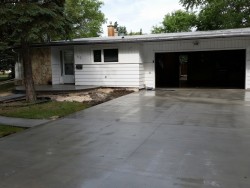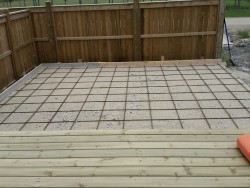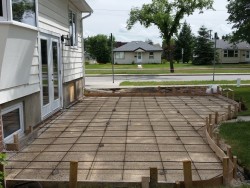Driveways
IntelCrete Concrete Works is a leader among residential concrete companies in Winnipeg Manitoba in both new concrete driveways and the breakout, removal and replacement of old concrete driveways with new ones at affordable prices. We pride ourselves in completing the whole process in a 3 days or less. All quotes in 2015 use minimum5 to 6 inches of 32 MPA concrete (Duramix from Burnco) with 10mm @ 15″ o.c. rebar and the best team of concrete finishers in Winnipeg to ensure quality and satisfaction every time.
Whether you are contracting us to build a broom finish (standard white concrete) or exposed aggregate (pebbley type finish), or stamped concrete in the Winnipeg area we use the same high standards of construction to make sure the job is done properly. To avoid cracking not only is it necessary to use the best materials available but ground preparation is often an overlooked but a hugely essential part of the process.
IntelCrete, based in Winnipeg, is meticulous in compacting the ground with heavy machinery and adding layers of tamped road crush to maximum compaction to control the concrete movement during the freeze and thaw of the harsh prairie winters. This dedication to quality stops cracking and deterioration of your concrete driveway in years to come. We will clearly explain to you the how, what and whys of the construction process so that you know you are getting a quality job for your money.
More about Concrete Driveways
Concrete driveways in Winnipeg have long been known to give trouble-free service to homeowners. The reason is simple. Concrete is enduring…many driveways last for 30 years and longer without major maintenance. Just as with many high-quality purchases, a concrete driveway will cost less in the long run.
From the street to the garage, a personally designed concrete driveway not only adds visual satisfaction…but also adds long lasting quality and value to your home as well. IntelCrete will help you design curves and textures as needed to create a higher quality driveway if you would like. Typically, driveways standards in Winnipeg are determined by the neighbour hood look and feel and the standards for that subdivision. Recently, in some of the higher end subdivisions of Winnipeg it is required to use either exposed aggregate or stamped and coloured concrete.
Concrete
IntelCrete Concrete Works uses minimum 32 MPA and most often Duramix concrete for jobs in the Winnipeg area. This satisfies all building standards and is minimum 32 MPA strength.
Planning
The quality of the completed concrete driveway always begins with good planning. Spending time at this stage is always a wise decision that can help to eliminate possible problems later on. One of the first things to consider is size. The suggested width for a single-car driveway is 8 to 9 feet. For double width, plan to use 15 to 18 feet. If the distance from the street to a two or more car garage is long enough, the initial entry approach can be of single-car width and then widened near the garage to accommodate all car stalls. If space is available, extra parking or a turn-around area can be included. Also, the planning stage is the time to consider adding that concrete patio or porch addition.
As for thickness, nonreinforced pavement 4 inches thick is standard for passenger car driveways. For heavier vehicles, a thickness of 5-6 inches is recommended. To eliminate standing water, the driveway should be sloped towards the street a minimum of 1%, or 1/8 inch per foot for proper drainage.
Many Design Options
Today’s concrete can be formed into practically any shape, texture, pattern, or color. It’s a way of adding a new dimension of quality and elegance to your home, at a reasonable cost.
Pattern stamping is an exotic and colorful way to enhance ordinary concrete paving. Essentially, the driveway is cast-in-place concrete which has been colored and imprinted with a pattern designed to look like brick, tile, cobblestone, or other various patterns. Textured finishes include broom finish, stamped and coloured concrete, and brown or grey exposed aggregate.
Site Preparation
When the basic driveway design has been decided, the next step is site preparation. As an example, let’s assume that an existing concrete driveway is being replaced with a traditional, broom-textured concrete driveway. In brief, this is how a typical site preparation works.
The existing layer of concrete is broken out and dumped by a machine, usually a Bobcat, with a special bit.. The existing gravel base is reusable so you will save money as opposed to a new concrete driveway..
The gravel base is compacted with a tamper. The picture to the right shows the process where one man is getting the right grade and the other is tamping with a machine tamper.
Lumber side forms should be placed and securely nailed to stakes in the ground. These stakes should be no more than 4 feet apart and should support each joint in the forming lumber. Measure for elevation and double check the base to insure uniform slab thickness.
Match the new driveway level with the existing garage slab and sidewalk. An isolation joint is needed where the drive is to meet these existing pavements. Typically ¼” to ½” thick premolded joint material is used to make this joint.
IntelCrete ties in 10mm rebar at 15” inches on center for all jobs we do except for basements. The Winnipeg area climate is tough on concrete so rebar should be put in all concrete slab subjected ot the elements here.
Additionally, we use rebar to tie into any adjacent concrete that we pour up against in most cases. We will most often dowel into house foundations whenever possible to keep the sidewalk, patio etc to stop from moving away from the building.
Placing & Finishing
Now it’s time for placing and finishing the concrete driveway. Ready mixed concrete should be delivered and discharged as quickly as possible. 1 to 1½ hours is usually a reasonable time frame. The following is the sequence for placing and finishing the new driveway.
Spray or brush all forms with form oil, and moisten the subgrade with water. Do not over water. There should be no puddles or standing water on the subgrade before placing the concrete. The concrete should be placed as near as possible to its finished position…either chuted directly, or into wheelbarrows and wheeled to its final location. Use of shovels are recommended to ensure complete filling along the sides of the forms.
Strike off the concrete with a straight piece of lumber to smooth the surface and bring the slab to its proper elevation. Check for any low spots. Another pass with the piece of lumber provides a uniform surface for the following finishing operations. Immediately after strike off, a bullfloat is worked back and forth across the surface to remove any irregularities. Don’t overwork, or the surface may be weakened. At this point, edges can be tooled into the concrete.
Surface bleed water must evaporate before proceeding with the final finishing. Properly specified concrete should allow finishing operations to begin almost immediately. A concrete broom is used for the final finish. Before brooming, the surface should be stiff enough to retain marks or grooves left by the bristles of the broom. A trowel finish is not recommended because it could leave the surface slippery and unsafe. The rougher broom finish improves traction. Snap chalk lines to indicate where joints go.
Curing
Curing is one of the most important and also the most often neglected phase of good concrete construction. Poorly cured concrete is more likely to crack and will not be as durable.
Curing should last for a least 3 days, and as long as 7 days, if practical. There are several methods of curing, including plastic sheets to cover the concrete, or continuous sprinkling, or applying a special curing compound. Curing should begin as soon as possible after the finishing operations. In areas experiencing colder temperatures, curing procedures may need to be adjusted.
Jointing
Joints in concrete pavements control the location and spread of cracks. They can be hand-tooled or saw cut, and should be made to a depth of no less than 1 inch for a four inch thick slab. Joints should be spaced no more than 10 feet apart for a 4 inch slab. Driveways that are wider, 12 feet or more, also require a joint down the center. Panels should be as square as possible, but in no case, should the long side be more than 1½ times longer than the shorter side. Jointing should begin as soon as possible after the finishing operations. If jointing is to be done with a hand groover, proceed when the concrete sustains foot pressure with only a ¼ inch indentation. If sawed, begin within 24 hours.
The above article focuses its attention on driveways but the same process is used for sidewalks, garage pads and patios.
Concrete Driveways F.A.Q.
What is the difference between cement and concrete?
Cement, more correctly called ‘Portland cement’ is a grey powder that reacts chemically with water. When cement is added to water, sand and stones this mixture is called concrete and this hardens into a rock-like material.
Does concrete sometimes crack?
As concrete hardens a small amount of shrinkage takes place. Cracks can develop when this shrinkage is restrained: for example by concrete slabs sticking to the ground or to adjacent walls. For more information on cracking please refer to CIP 4 in the ‘Concrete in Practice’ series.
How is cement made?
Limestone is heated in a rotary kiln where it undergoes a chemical change and is then finely ground into a powder. In most cement plants several other natural ingredients are added to the limestone to adjust the chemistry, the most common of these are marl, shale, iron ore and gypsum.
What does ‘curing’ of concrete mean?
Concrete continues to gain strength as long as it is maintained in a moist condition and very cold temperatures are avoided. ‘Curing’ is the maintaining of satisfactory temperature and moisture conditions for the concrete. There are a number of alternative methods for curing concrete. For more information on this topic please refer to CIP 11 in the ‘Concrete in Practice’ series.
What ingredients go into concrete?
The main ingredients of concrete are cement, water, sand and coarse aggregate (gravel or crushed stone). One or two chemicals are normally added at a ready-mixed plant to improve the performance of the concrete. The most common admixtures used are water-reducers that improve the strength and air-entraining admixtures that make the concrete resistant to cycles of freezing and thawing. For more information on admixtures please refer to CIP 15 in the ‘Concrete in Practice’ series.
What determines how strong concrete will become?
The most important factor influencing the strength of concrete is the ratio of water to cement in the mixture. The lower this ratio is, the stronger will be the concrete. Therefore the easiest way to increase the strength of concrete is to use more cement in the mixture; the easiest way to weaken concrete is to add more water.
What is ‘air-entrained’ concrete?
Air-entrained concrete contains billions of microscopic air bubbles that enable the concrete to resist the damaging effects of freezing and thawing. This is achieved by the addition of an air-entraining admixture at the ready-mixed plant. Air-entrained concrete should be used whenever concrete will experience freezing so is essential for driveways, patios, footpaths and roads in cold or temperate climates. Air-entrainment cannot be achieved when mixing concrete by hand.
Can it be too hot or too cold to place concrete?
When concrete is placed in very hot and sunny conditions it tends to dry out. When completely dry no further strength will be achieved. Similarly when the temperature approaches freezing the hydration slows to a standstill. Concrete can be placed under hot and cold conditions provided that appropriate curing methods are used to protect the concrete from these adverse effects.
What kind of joints should be used in concrete paving (such as a driveway)?
The most common joints used in concrete paving are called ‘control joints’. These are to accommodate the shrinkage that is normal in concrete. ‘Isolation joints’ may also be required to separate the paving from posts, drains, or adjacent walls.
What causes light and dark patches in some concrete?
Discoloration is a lack of uniformity in the colour or tone of the concrete. There are a number of different types of discoloration with different causes. The most common type, known as ‘trowel burn’ results from placing and finishing concrete after the hydration has started and the concrete is beginning to set. For more information on this topic please refer to CIP 23 in the ‘Concrete in Practice’ series.
How thick does a concrete driveway need to be?
Throughout North America it is conventional to form residential driveways with 2″X4″ lumber. This results in a pavement thickness of approximately 3.5 inches or 80mm. This thickness is adequate for cars, pick-ups and SUVs. If heavier commercial vehicles will use the driveway more frequently then a greater thickness of concrete is needed. IntelCrete always pours to a depth of 4 to 6 inches with 32 MPA Duramix concrete in the Winnipeg area.
How is the strength of concrete measured?
The strength of concrete generally refers to its compressive strength. This is measured by casting cylinders while the concrete is still plastic and crushing them after 28 days. Most concrete has a specified 28 day strength between 20 MPa (3000 psi) and 35 MPA (5000 psi). If cylinders are not made cores can be drilled from the hardened concrete at any age and tested in the same way.
Who invented cement and when?
Cement was used throughout the Roman Empire using limestone as its main ingredient and volcanic ash when it was available. The cement used throughout the world today is credited to Joseph Aspdin, a brickmason of England who patented his process in 1824. He called this product ‘Portland cement’ because the concrete produced resembles the natural stone quarried at Portland, England.
What is the tallest concrete building in the world?
The tallest free-standing structure in the world is the CN Tower in Toronto, Canada. This stands at 554 metres. However it is argued that the CN Tower is not really a building even though it has a restaurant and observation tower. The tallest building in the world is currently the Taipai 101 tower in Taipei, Taiwan. Completed in 2004, this tower rises to 509 meters, and has 101 floors. Both the CN Tower and Taipei 101 were constructed in concrete.
How can stains be removed from a concrete driveway?
The most common stains affecting concrete driveways are oil stains, rust and tire marks. Almost all stains can be removed from concrete and even the most severe can be substantially improved.

